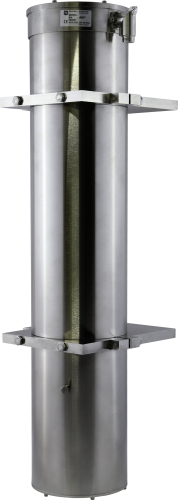
Passive no-contact detector, ideal replacement for snow pillow






Overview
The CS725 measures snow-water equivalent (SWE) by passively detecting the change in naturally occurring electromagnetic energy from the ground after it passes through snow cover. It is mounted above the ground and has no contact with the snow. As the snow pack increases, the sensor detects the attenuation of the electromagnetic energy from the ground, and SWE can be calculated. The measurement area of the CS725 is 50 to 100 square meters (540 to 1,075 square feet), making it an excellent replacement sensor for the traditional snow pillow and snow scale.
Common applications for the CS725:
- Hydroelectric power forecasting and hydropower potential forecasting (Read the "Northern Canada: Hydro-electric Power Forecasting" case study.)
- Seasonal run-off management
- Flood forecasting and risk management
- Irrigation planning and management
Benefits and Features
- Non-contact measurement
- Excellent replacement for traditional snow-pillow sensors
- Does not cause the melt of light snow
- Greatly reduces the need for site visits
- No site preparation or earthworks required for set-up
- Performance not affected by rainfall or snowfall
- Effective with any type of snow or ice
- Will not cause snow drifting
- Seven-year maintenance cycle
- No antifreeze chemicals used (i.e., glycol)
Images

Technical Description
The CS725 is powered using 12 Vdc and can either operate in a stand-alone mode, or be easily interfaced to a datalogger. With the addition of a wireless communication option, SWE values can be transmitted in real-time from remote sites.
Compatibility
Please note: The following shows notable compatibility information. It is not a comprehensive list of all compatible products.
Dataloggers
| Product | Compatible | Note |
|---|---|---|
| CR1000 (retired) | ||
| CR3000 (retired) | ||
| CR6 | ||
| CR800 (retired) | ||
| CR800 (retired) | ||
| CR800 (retired) | ||
| CR800 (retired) | ||
| CR850 (retired) | ||
| CR850 (retired) | ||
| CR850 (retired) | ||
| CR850 (retired) |
Additional Compatibility Information
Collimator Considerations
Other sources of electromagnetic radiation (40K) such as trees, vegetation, and buildings that are not covered by the same amount of snow as the ground can affect the readings. To filter these signals, the optional heavy steel collar (collimator assembly, pn 29390) is installed on the bottom of the CS725.
The following chart outlines when a collimator should be used:
| Site Characteristics | Maximum SWE 300 mm | Maximum SWE 300 to 400 mm | Maximum SWE > 400 mm |
|
Very open site with no proximity to trees, buildings, or tall vegetation within a 48 m (160 ft) radius |
Optional |
Optional |
Optional |
|
No trees, buildings, or tall vegetation within a 24 m (80 ft) radius |
Optional |
Optional |
Required |
|
No trees, buildings, or tall vegetation within a 12 m (40 ft) radius |
Optional |
Required |
Required |
|
Site with minimum clearance radius of 6 m (20 ft) radius |
Required |
Required |
Required |
Note: Always confirm that your sensor has the “Collimator Installed” parameter set properly. The SWE calculations are different for a sensor with and without a collimator.
Specifications
| Measurement Range | 600 mm maximum water equivalent |
| Accuracy |
|
| Resolution | 1 mm |
| Coverage Angle | 60° |
| Operating Temperature Range | -40° to +40°C |
| Power Requirements | 11 to 15 Vdc |
| Power Consumption | 180 mA |
| Output Options | RS-232 (1200 to 115200 bps) |
| Cable Type | Four conductor, two-twisted pair, 22 AWG, Santoprene jacket |
| Warranty | 2 years |
| Maximum Cable Length | 30 m (98.43 ft) |
| Diameter | 12.7 cm (5 in.) |
| Length | 62 cm (24.4 in.) |
| Main Body Weight | 9 kg (20 lb) |
| Collimator Weight | 25 kg (55 lb) |
| Total Weight | 34 kg (75 lb) |
Related Documents
Related FAQs
Number of FAQs related to CS725: 5
Expand AllCollapse All
-
The CS725 should be installed prior first snow fall to establish a good baseline reading. However, it can be installed after and the data back-calculated at the end of season. The only problem with this is you won’t have accurate SWE values during the season.
-
The sensor takes the measurement and outputs data in RS-232 format. If your data logger can receive RS-232 signals, it should work with the CS725. It’s also best that the data logger can measure volumetric soil moisture.
-
No, it only measures naturally emitted gamma radiation coming from the ground. The strongest signal of gamma comes from potassium-40 (40K).
-
No, at this time the sensor does not output in SDI-12 format; however, it may be added in the future.
-
Yes, however the data would have to be back-calculated at the end of the season once all snow has melted, you would not have real-time SWE measurements.
Articles and Press Releases
Case Studies
Climate change is an important global issue that poses challenges to many facets of our......read more